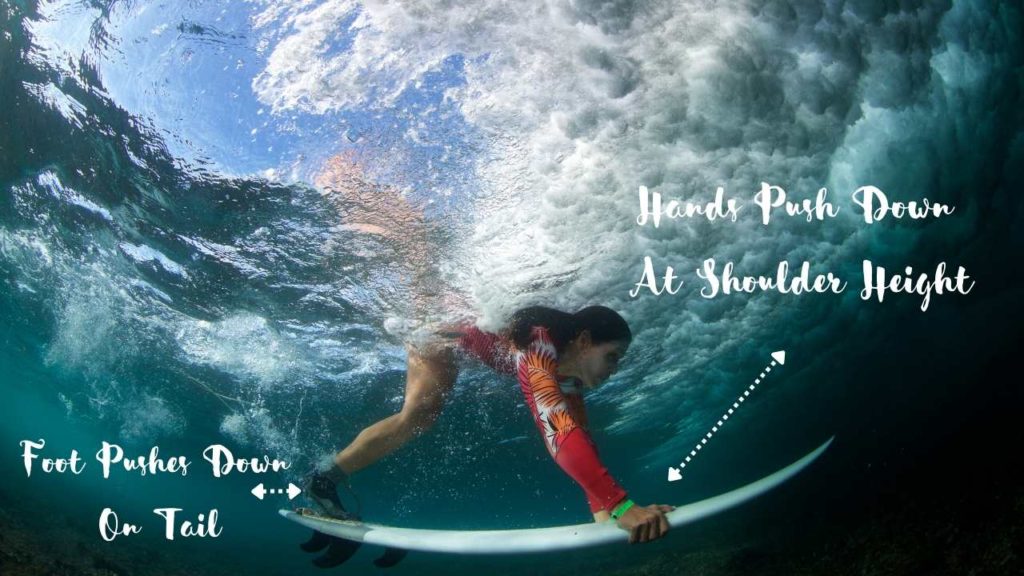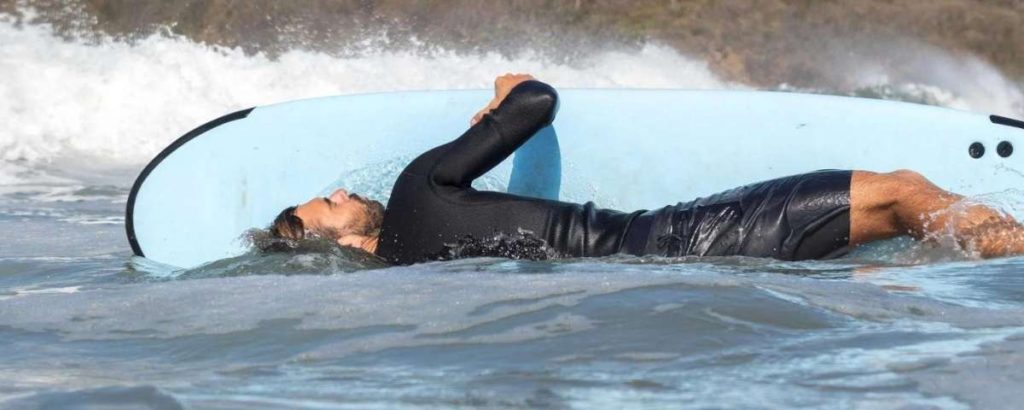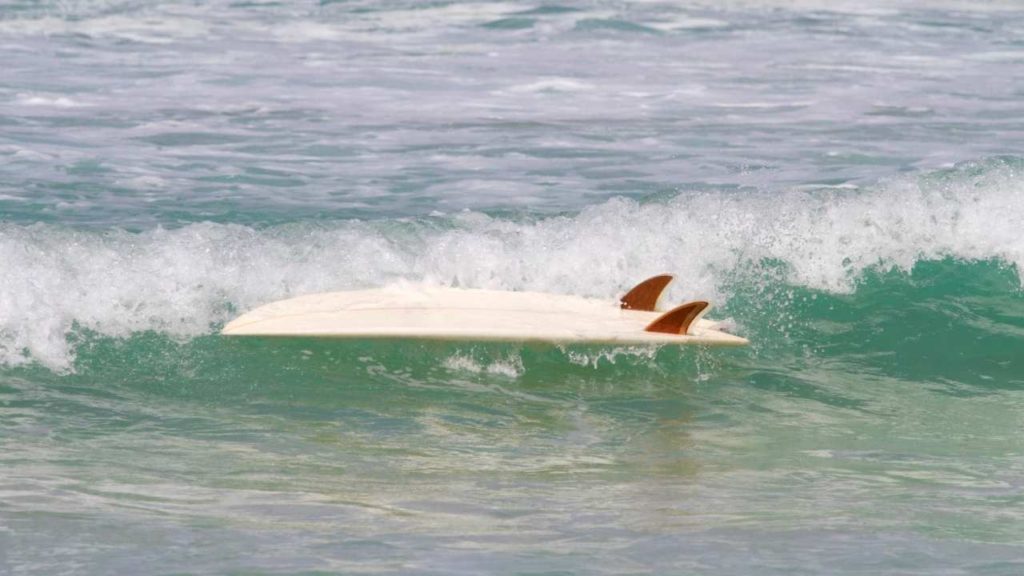The hardest thing about surfing is all the paddling you need to do to get into the right spot to catch a wave. From the shore, you are faced with a barrage of waves that you must pass through to get to the outside.
Duck diving, turtle rolling, punching thru waves, these are all methods surfers employ to get thru the surf zone to where the waves begin to break. The wave and the board you are riding determine which method you will use to get through the surf zone.
I want to make sure you have all the tools that you need to make it through the surf zone. This guide was developed for you to know all of the ins and outs of duck diving, turtle rolling or punching through waves.
I wish something like this was available when I first got started. I had to learn by watching.
How To Paddle A Surfboard
We have to start with the basics, because if you do not know how to paddle a surfboard, everything else is going to be really hard.
It might be a good idea to pick a spot with no waves to practice paddling before you do it in a surf zone. You can also get your paddling muscles in shape this way.
Whether it be a shortboard or a longboard (preferably longboard if you are just beginning), place it in the water and hop on. Hopefully you waxed it up first or might slip right off, check out this article on waxing your boards.
Center your body over the stringer and move yourself up or down on the board until the nose of the surfboard is just out of the water. You donʻt want it shooting up too high nor do you want it pearling under the water, balance is key here.
Once youʻve found that balance spot, take a few strokes. Alternating arms with your palms flat like a paddle, reach and pull your arms through the water, similar to a freestyle stroke while swimming.
Experiment with changing speeds, or what itʻs like to paddle with both arms at the same time, or how it feels when you move your body forward on the board, or back.
Get a good feel of the surfboard before paddling out into a spot with surf. If you do, youʻll be that much more confident.
To take your paddling to the next level, read this post.
Best Way To Paddle Back Out
Experienced surfers always watch the surf before they paddle out. They look for patterns in the surf zone. Theyʻll identify ways to paddle out through surf zones that look impossible to others. You can learn to do the same.
Observe the surf, look for the patterns and exploit them. Surfers at Pipeline, one of the heaviest breaks in the world, can sometimes paddle out to the surf zone in maxing surf without even getting their hair wet. Because they recognize patterns.
Look for channels, or breaks in the waves where the water might be deeper. Use rip currents to your advantage. Time your paddle to happen in between the sets. Doing this will help save your energy for what really matters, catching waves.
Now, I know we canʻt always make it out to the lineup with dry hair. At some point, you will have a wave staring down at you, blocking your path to the outside lineup. But donʻt worry, there are tricks to help you get through that wave without getting obliterated.
Duck Dive Or Turtle Roll?
If youʻve already tried paddling out, you may have already had this question pop up in your head as you faced an oncoming wave. Which one do I choose to do, to duck dive or to turtle roll? Luckily, the answer is pretty simply.
If you are riding a surfboard 7ʻ6” or smaller, duck diving would be the better option for getting under waves. Surfboards 7ʻ6” and above and you will most likely be using the turtle roll if a wave is coming at you.
The reason is simple, there is too much volume in a larger board to be able to push it low enough below the surface of the water to get past a wave. You may be able to muscle it down if youʻre a big guy, but for everyone else, youʻll be turtle rolling that longboard when a wave is heading towards you.
Duck Diving: A Shortboarders Best Friend
Duck Diving is not always an easy skill for most surfers to master, but it is one that every surfer must learn. To dive under a wave with your surfboard takes wave knowledge, a clear understanding of how it is done and perfect timing to successfully make it through.
A surfer can learn the basics of duck diving in a single surf session, but to be proficient in the skill may take 40 hours+ in the water. It takes time to know how waves work, what it feels like to duck dive a 6ʻ wave as opposed to a 2ʻ wave, and so on.
As we already mentioned, the smaller the board, the easier it will be to duck dive it. A larger board will require an adjustment in timing in order to successfully duck dive.
If you are using a foam or epoxy surfboard, be aware that they can be harder to duckdive because of their buoyancy. You would have to push down harder and start your duckdives earlier in order to be successful with these types of surfboards.
How do you duckdive?

As you paddle back out to get to the lineup and a wave approaches, timing and positioning is crucial. Start of by paddling directly towards the wave, turning towards the side in any way can result in the wave taking you through the washing machine.
When the wave is about 5ʻ- 6ʻ away from you (more if you have a bigger board), place both hands on the rail closer towards the nose and push it under the water surface. Next, use your foot to press down on the tail and push that end of the board under water as well.
These two movements happen almost simultaneously.
The nose of your board should be leading the way throughout the duckdive.
You can use your knee to duckdive, but I only use it for shallow duckdives. The knee tends to put pressure dings into the deck of your board and canʻt get you as deep.
As you push yourself down, imagine the wave rolling right over you. Stay under the wave for as long as you can imagine it would take for the turbulence above you to pass by. Then pop up on the other side and continue paddling.
How deep do you need to duck dive?
With waves 3ʻ or less, you use shallow duckdives that use the knee. Waves in the 3ʻ – 6ʻ range require duckdiving with the foot pushing down on the tail, bringing you about 2ʻ – 3ʻ under the water surface. Waves larger than 6ʻ require duckdives that can get you down 4ʻ or more below the surface.
But everything is relative when it comes to mother nature. A 3ft wave at Pipeline is very different than a 3ʻ wave at Waikiki. If the wave is barrelling as opposed to mushy, you will have to adjust your duckdives accordingly (but you wonʻt be paddling out at Pipeline, will you?).
How do you practice duck diving?
Duck diving is one of those things that is best practiced in the water by trying to paddle through a lineup, as simple as that.
The only way to build up your wave knowledge, which is an important skill for mastering duckdives, is to put in the hours.
Start on a small day and duckdive as much as you can. Go under as many waves as possible. Forget about surfing. Duckdive. Duckdive. Duckdive.
Not only would an exercise like this improve your duckdiving skills, but it will also enhance your paddling stamina, preparing you for when the waves get good!
You can practice duckdiving on land.
- Place your board on the sand
- Lay down on it as if you were paddling
- Bring your hands to either side of the rails, just above your chest and push down.
- Bring your back foot to the tail and push up to a one legged down dog.
- Release.
Practicing on land can help your body get used to the motions, but there really is no substitute for getting out there and actually practicing it in the surf.
If you still consider yourself a beginner and are interested in teaching yourself how to surf, you NEED to read this post, it will make your life SO much easier.
Big Boards & The Turtle Roll

As a general rule of thumb, if your surfboard is over 7ʻ6” you will probably utilize a turtle roll to get under a wave. Iʻve always kind of loved this method, simply because Iʻm amazed by how well it works.
I regularly take my 10ʻ longboard out into waves that are about 6ʻ+ or so and find myself caught inside from time to time. All I have to do when I have to get through a wave is point my board straight at a wave, flip it over, hold on, wait for it to pass over me and then flip back over.
Each and every time I expect it not to work, but it has never failed me.
Letʻs go over the steps it takes to turtle roll a longboard.
- Paddle your board directly at an oncoming wave.
- Just as it approaches, grab the rails and flip yourself and your board upside down.
(Some surfers will sit up on the board, wrap their legs around the rails, then grab the rails with their hands then flip over. - Continue to hold on to the board as the wave passes over head.
- Just as it passes, try to use the momentum of the wave to help flip you back over.
- Position yourself back onto your board and continue paddling out.
Take your big board out into little waves and give it a try. I think youʻll be surprised at how easy it really is.
You may notice after turtle rolling on a few really small waves, it isnʻt always necessary. The smaller waves are weak enough to just punch on through a wave, which brings us to our next method of getting past a wave.
Punching Through Waves
If a wave is small, 3ʻ or less, or really mushy, you may be able to punch straight through a wave without having to duckdive or turtle dive.
To punch through a wave, paddle extra hard directly at the oncoming wave. As it approaches, slide up just a bit on your surfboard and hold on. You may push up with your hands, doing a sort of updog motion as you punch the board through the wave.
If you do it successfully, then you were able to punch on through and continue paddling. If you end up losing your board or having to fight too hard to hold on, then the wave was probably too big and it may have been better to duckdive or turtle dive.
When To Bail On A Surfboard

To bail or not to bail, that is the question. In a crowded lineup, it is almost never ok to bail on your surfboard. The risk of injuring someone else is just too great. It is important for you to take the beating, not somebody else.
But sometimes bailing is your only option. The wave heading your way is just too big and you know that there is no way that you are going to be able to duckdive or turtledive it successfully. As long as no one is around you then go ahead, do it. But make sure no one is there, and wear a surf leash for the safety of all of us.
If the wave is especially large, bailing may be your only option and even then you better make sure you get down deep. You can sort of hop up in the water to get yourself down even further before the wave crashes over you. Stay under for as long as it takes for the wave to pass over you.
Bailing really is a last case sort of option. Try your best to go with the other options before you resort to bailing.
Time To Practice
Well, thatʻs about it. Everything Iʻve learned about paddling back out over 30 plus years of surfing. Hope this helps make it easier for you the next time you need to paddle back out.



